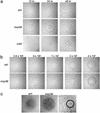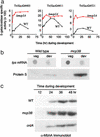Chemosensory regulation of developmental gene expression in Myxococcus xanthus
- PMID: 12566562
- PMCID: PMC149949
- DOI: 10.1073/pnas.0330944100
Chemosensory regulation of developmental gene expression in Myxococcus xanthus
Abstract
The delta-proteobacterium Myxococcus xanthus coordinates its motility during aggregation and fruiting body formation. While searching for chemotaxis genes in M. xanthus, we identified a third chemotaxis-like gene cluster, the che3 cluster, encoding homologs to two methyl-accepting chemotaxis proteins (MCPs), a CheW, a hybrid CheA, a CheB, a CheR, but no CheY. Mutations in mcp3A, mcp3B, and cheA3 did not show obvious defects in motility or chemotaxis but did affect the timing of entry into development. Mutations in these genes caused early aggregation of starving cells, even at low cell densities. Furthermore, these mutants showed pronounced overexpression of the developmentally regulated Tn5lac fusions Omega4403, Omega4411, and Omega4521 as well as overexpression of mbhA and tps, markers for peripheral rods and aggregating cells, respectively. Divergently transcribed from the che3 promoter region is another gene, crdA (chemosensory regulator of development), predicted to encode a transcriptional activator of sigma(54)-dependent promoters. To test the hypothesis that CrdA functions as the cognate response regulator for the histidine kinase CheA3, CrdA and CheA3 were assayed and found to interact strongly in the yeast two-hybrid system. Mutant analysis showed that crdA cells were delayed in development (12-24 h) and delayed in MbhA production relative to the wild type. An mcp3BcrdA double mutant displayed the crdA phenotype, indicating that crdA is epistatic to mcp3B. We conclude that the Che3 chemotaxis-like system functions to control developmental gene expression by regulating a sigma(54) transcriptional activator, CrdA.
Figures





References
Publication types
MeSH terms
Associated data
- Actions
Grants and funding
LinkOut - more resources
Full Text Sources
Other Literature Sources

